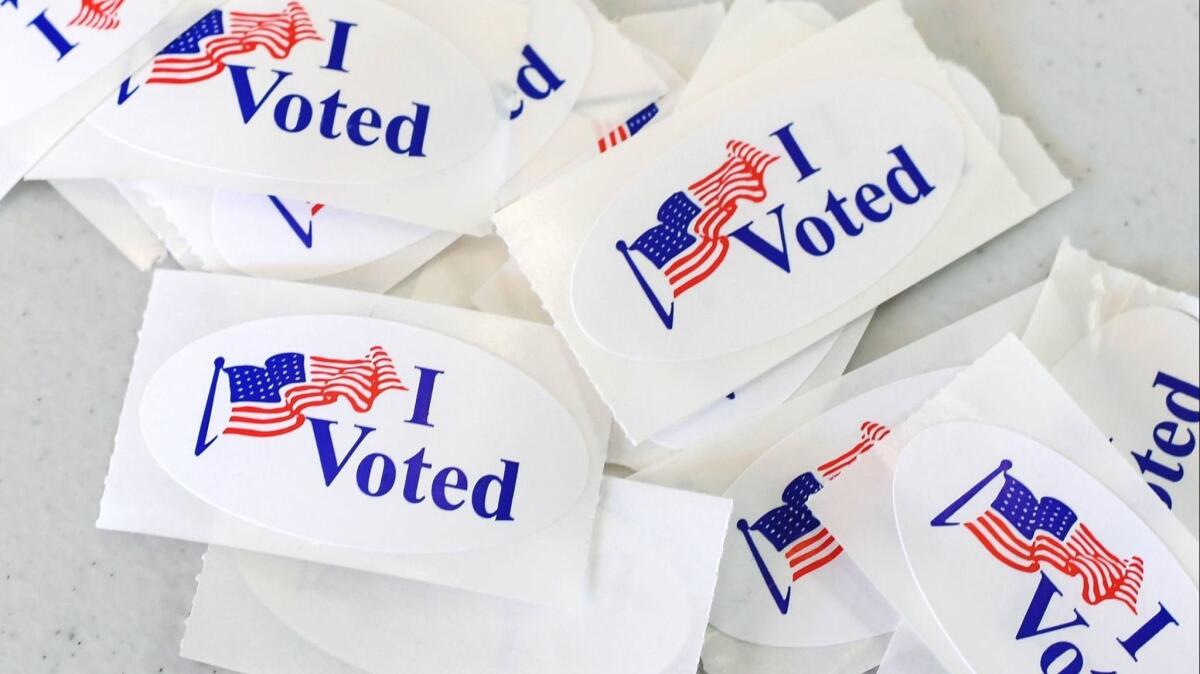California’s not goofy, it’s really big. That’s why counting the vote takes so long

An eager nation waits breathlessly as California counts its election ballots.
Well, not an entire nation. Just a bunch of political obsessives and some candidates in limbo, anxious to find out whether they’re headed to Washington as lawmakers or have a little extra time on their hands to draw up that perfect Thanksgiving menu.
Nearly 5 million ballots remain to be counted statewide, leaving four congressional contests, in the Central Valley and Orange County, still to be decided.
Democrats have already picked up two seats in California, in the high desert outside Los Angeles and in coastal Orange and San Diego counties, and they could gain as many as five more once the final results are known.
Elections are sacred, part of the majesty of our democratic process, renewing and replenishing our republic, like fresh water to a spring. Thus, the prolonged tabulations are wreathed in a swelling chorus heard throughout the land: What the heck is taking so long?!

Voter turnout in Los Angeles County will remain unclear immediately after the elections because of the rising number of mail-in ballots.
So what the heck is taking so long?
The short answer is there are just a whole lot of votes to be counted, a result of policies enacted to encourage the greatest voter participation possible and, once votes are cast, to make every effort to ensure those ballots are properly counted.
But the election was Tuesday!
And votes have been pouring in ever since. Any mail-in ballot that was postmarked by midnight, Nov. 6 — election day — will be counted, so long as it was received by Friday’s close of business.
So it’s not as though election officials are out surfing or lingering over their macrobiotic tofu-and-bean-sprout sandwiches while ballots stack up uncounted. The overwhelming majority of ballots cast were sent by mail, and many arrived on or after election day.
Hmmm...
And don’t forget California is big. Really big. The state has nearly 20 million registered voters. Two counties alone — Los Angeles and Orange — have more voters than 30 states.
And it takes work to make sure every ballot that’s cast is legitimate.
That may mean looking up an individual’s address or verifying his or her signature. Or routing a mail ballot, dropped off at the wrong polling location, to its appropriate county for processing.
Uh-huh.
There are also a ton of provisional ballots that need to be processed.
If people show up and are not on the voter roll, due to, say, a clerical error or because they’re in the wrong place, they are nevertheless allowed to cast their vote. Those need to be checked out afterward.
California also has same-day registration, which means further work verifying a whole lot of ballots after they’re cast.
All that takes time, said Sam Mahood, a spokesman for Secretary of State Alex Padilla, who oversees California’s election process.
A lot more time than it takes in a state such as Wyoming, with 275,000 voters — which is about as many as Sonoma County, in Northern California’s wine country.
Couldn’t it all be done on touch screens, by computer?
The use of touch screens is highly controversial, because of concerns about security and possible tampering. And so, as a matter of law, every ballot in California is a paper ballot. There are exceptions; some machines are used to accommodate voters with disabilities, but even those votes require a verifiable paper record.
So who’s left hanging at this point?
The congressional race in California’s 10th District, in the San Joaquin Valley, remains too close to call. Three-term GOP incumbent Jeff Denham was slightly ahead of Democratic challenger Josh Harder.
In Orange County, there are three more races up in the air.
Republican Young Kim holds a narrow lead over Democrat Gil Cisneros in the race to fill the seat vacated by retiring GOP Rep. Ed Royce in a district that also includes parts of Los Angeles and San Bernardino counties.
Two-term Republican incumbent Mimi Walters was ahead of Democratic challenger Katie Porter in inland Orange County.
Along the coast, Democratic challenger Harley Rouda enjoys a healthy lead over Republican Dana Rohrabacher in his bid to oust the 15-term incumbent.
There are tens of thousands of ballots still to be counted in those four contests.
So who’s going to win?
Oh, boy.
What’s the matter?
Just having terrible flashbacks to “what does the early vote mean?”
Aw, c’mon.
With rare exceptions, close races in California tend to move in Democrats’ direction — typically by 2 percentage points, according to Political Data, a firm that tracks voter trends. So several of those seats could end up tipping away from the GOP.
The reason is that early voters, typically older white Californians who begin mailing their ballots weeks before election day, lean Republican. Democratic voters, many of them young and minority, prefer to vote in person or mail their ballots in later.
Recent history bears this out. To cite just two examples from 2014, Republican Carl DeMaio led by a few hundred votes the day after the Nov. 4 election, but mail and provisional ballots counted in succeeding days boosted San Diego Democrat Scott Peters into the lead and a return to Congress.
In the same election, Democratic Rep. Ami Bera trailed for more than a week before pulling ahead and winning reelection against Republican challenger Doug Ose in the Sacramento suburbs.
So will this go on forever?
No, the secretary of state will officially certify the final results in mid-December.
Mid-December?
Yep. On Dec. 14. So chill. Go surf. Or fix yourself a macrobiotic sandwich.
Twitter: @markzbarabak
More to Read
Get the L.A. Times Politics newsletter
Deeply reported insights into legislation, politics and policy from Sacramento, Washington and beyond. In your inbox three times per week.
You may occasionally receive promotional content from the Los Angeles Times.











